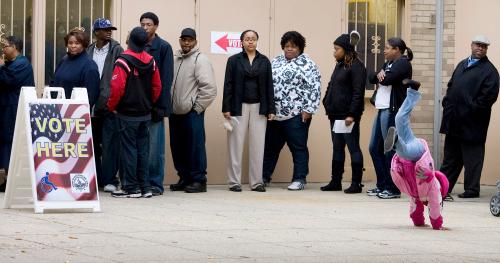As we move closer to Election Day, it is becoming clear that college-educated white women will be a key voting bloc for Hillary Clinton, serving as a counterweight to Donald Trump’s support from working-class white men. This is evident in polls taken since mid-summer and could translate into a sizeable vote advantage for Clinton, according to simulations I conducted and depicted in our latest video of the Diversity Explosion: Election 2016 series.
The likely voting haul delivered to Clinton by educated white women would be precedent shattering. While Democratic presidential candidates have done better with women than men since 1980, white women have tended to vote Republican—just less so than their male counterparts.
Despite voting for Republican Mitt Romney in 2012, college-educated white women have voted with modest Democratic margins in several previous elections. Further hints that they could be seriously moving into the Democratic camp were revealed in their more progressive stances on issues like immigration and government regulation in a 2015 Pew survey.
Yet the recent, sharper shift of these women toward Democrat Clinton’s candidacy became evident after the party conventions. In August, Clinton held a 19 percent (Democrat minus Republican) vote margin, well above her pre-convention margin of 3 percent, in Washington Post/ABC polls.
Now with women’s issues coming to the fore, Clinton’s support among college-educated white women has become amplified. A PRRI/The Atlantic poll taken October 5-9 raises the Clinton vote margin for these women to 39 percent. In contrast, white men without college educations show a Trump margin of 43 percent. Among other groups in this poll, racial minorities hold a Clinton margin of 55 percent, white college educated men hold a Trump margin of 7 percent, and white women who did not graduate from college split evenly between Clinton and Trump.
This rise in support of college-educated white women, when coupled with the strong backing of racial minorities, would provide a huge advantage for Clinton in the final vote tally. After the early August polls came out, I calculated that, if they persisted to election day, Clinton could win by more than 10 million votes–a number exceeded by only Nixon in 1972, Reagan in 1984, LBJ in 1964, and FDR in 1936.
When conducting a similar simulation with the early October poll numbers, the Clinton advantage rises to 17 million votes. Clinton’s combined support among college-educated white women and minorities is so large that it could withstand a supersized turnout of Trump-leaning non-college educated white men. In another simulation, I assumed that those men would increase their turnout by 75 percent over that in 2012. Even then, Clinton would win by 8 million votes.
Increased Democratic support among educated white women could become especially crucial to Clinton in Rust Belt states with high shares of working-class white men and relatively small minority populations. In 2012, President Obama won Ohio, Pennsylvania, and Wisconsin, among others, because the strong racial minority support for him outweighed the white support for his Republican opponent. But in this election, Democrat Clinton may need to counter even higher turnout numbers for working-class white men in these states.
It is certainly possible that the early October poll numbers, displaying unprecedented Democratic support among college-educated white women, are inflated by events surrounding the dates of that poll (such as the release of Trump’s “Access Hollywood” video). But other post-convention polls have been fairly consistent in showing Clinton with solid numbers among this bloc. If she retains this support through Election Day, Clinton will not only win big but may have created an important constituency for Democrats in the future.
Watch the full Diversity Explosion: Election 2016 video series to learn how other key demographics are impacting this year’s election. Read more on demographics shaping America in “Diversity Explosion.”
The Brookings Institution is committed to quality, independence, and impact.
We are supported by a diverse array of funders. In line with our values and policies, each Brookings publication represents the sole views of its author(s).




Commentary
WATCH: The power of the educated white female vote in election 2016
October 18, 2016